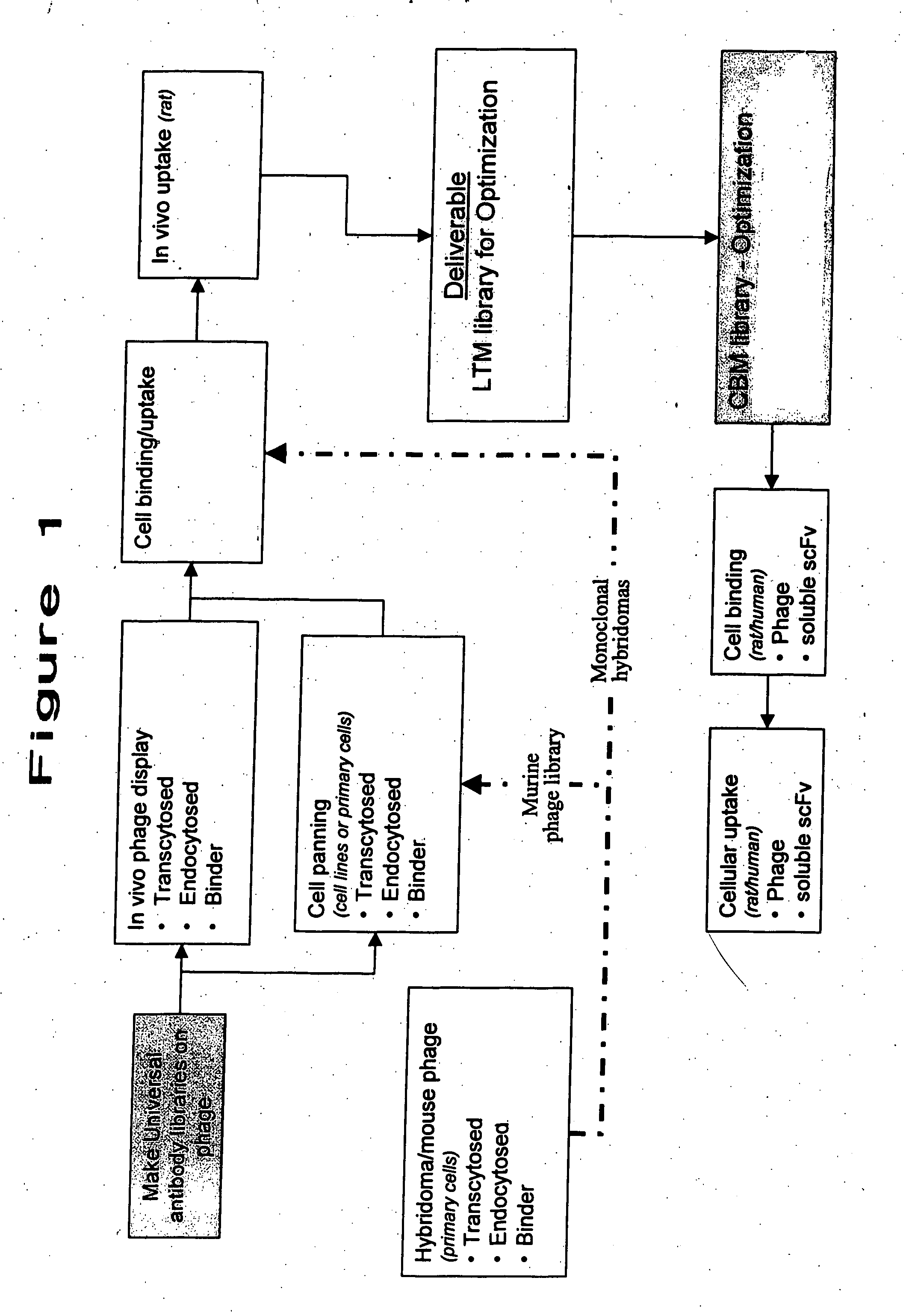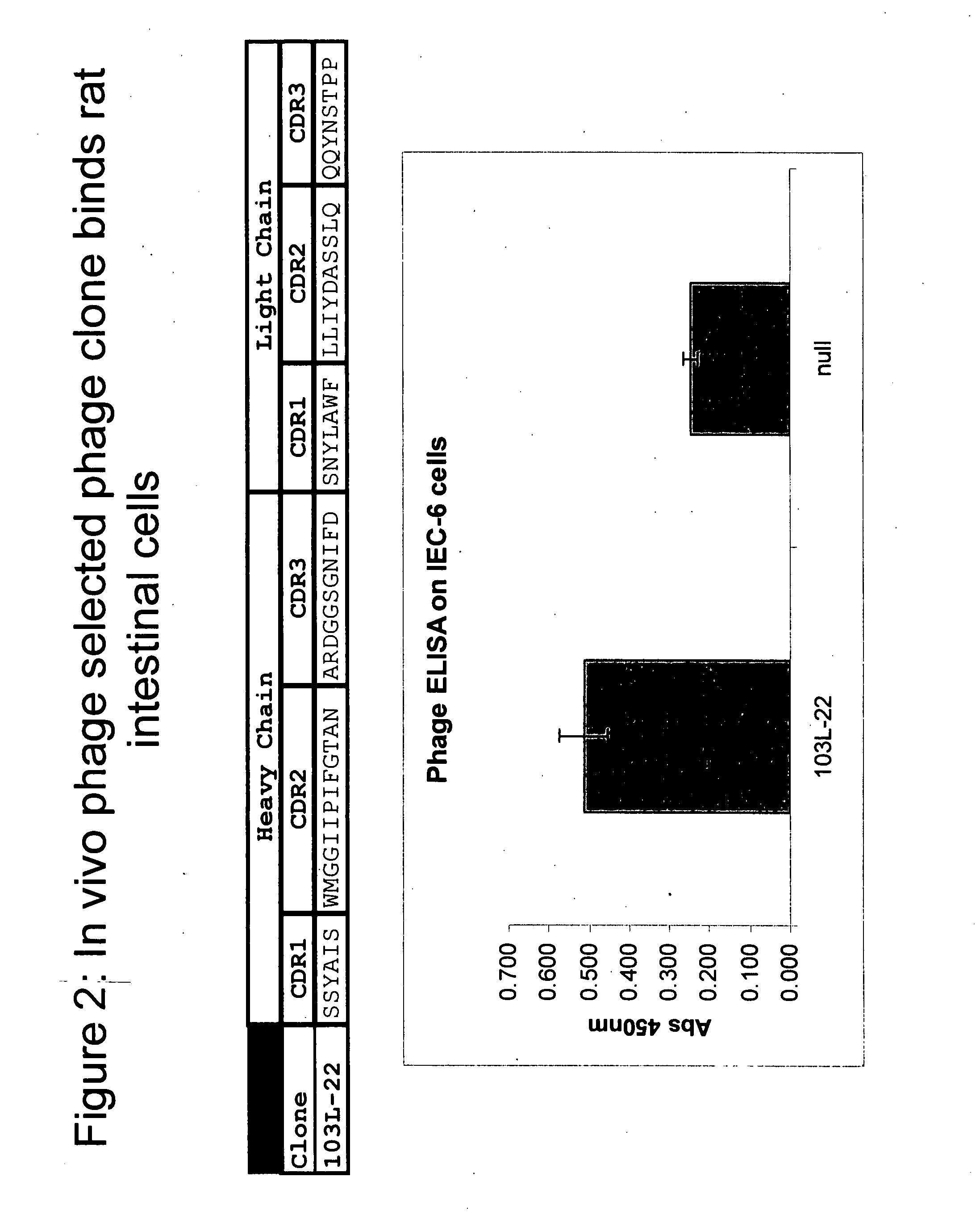Facilitation of translocation of molecules through the gastrointestinal tract
a technology of gastrointestinal tract and gastrointestinal tract, which is applied in the field of facilitating the translocation of molecules through the gastrointestinal tract of mammals, can solve the problems of limiting the use of antibodies, proteins and peptides outside of the hospital setting, and limiting the oral delivery of such molecules, so as to achieve the effect of increasing the translocation of molecules
- Summary
- Abstract
- Description
- Claims
- Application Information
AI Technical Summary
Benefits of technology
Problems solved by technology
Method used
Image
Examples
example 1
Identification of Antibodies Capable of Translocation Through the Gastrointestinal Tract by In vivo Phase Display
[0131] The present Example describes the use of in vivo phage display technology to screen an antibody scFv phage library for clones that specifically pass through the mucosa.
[0132] Methods
[0133] In vivo Surgical Methods
[0134] The following four in vivo surgical methods were investigated to deliver phage into the small intestine of starved male Sprague-Dawley rats: [0135] 1. Intraduodenal injections (IDC): Direct injections into the duodenum. [0136] 2. Gutloop: An exteriorized section of the ileum was ligated with suture, and the phage library was directly injected into the closed section. The phage was incubated 15 minutes in the rat prior to sacrifice. [0137] 3. Intrajejunal cannula (IJC): Rats were surgically implanted with cannulae into the jejunum approximately 5 days prior to dosing. The phage library was injected into the cannula and incubated 15 minutes in the...
example 2
Binding to Rat Intestinal Cells
[0155] The ability of a clone selected by in vivo phage display to bind rat intestinal cells was tested, using the following protocol.
[0156] First, IEC-6 cells previously grown in monolayers were trypsinized and washed twice with PBS. Next 500,000 in 0.1 ml PBS were distributed into each well of a V-bottom polypropylene 96-well plate. To these wells 0.05 of scFv phagemid supernatents (˜1×1010 phage) were added and allowed to incubate for one hour at 4 degrees. Next, cells were pelleted by centrifugation and then washed three times with 0.180 ml cold PBS. The pellets were then resuspended in 0.05 ml mouse anti-m13 antibody (diluted 1:1000) in PBS / 1% BSA and incubated for one hour at 4° C. Next, cells were pelleted by centrifugation and then washed three times with 0.180 ml cold PBS. Following the wash the cells were resuspended in 0.05 ml goat anti-mouse IgG-HRP (diluted 1:1000) antibody in PBS / 1% BSA and incubated for one hour at 4° C. -Following thi...
PUM
| Property | Measurement | Unit |
|---|---|---|
| volumes | aaaaa | aaaaa |
| permeable | aaaaa | aaaaa |
| stability | aaaaa | aaaaa |
Abstract
Description
Claims
Application Information
 Login to View More
Login to View More - R&D
- Intellectual Property
- Life Sciences
- Materials
- Tech Scout
- Unparalleled Data Quality
- Higher Quality Content
- 60% Fewer Hallucinations
Browse by: Latest US Patents, China's latest patents, Technical Efficacy Thesaurus, Application Domain, Technology Topic, Popular Technical Reports.
© 2025 PatSnap. All rights reserved.Legal|Privacy policy|Modern Slavery Act Transparency Statement|Sitemap|About US| Contact US: help@patsnap.com


